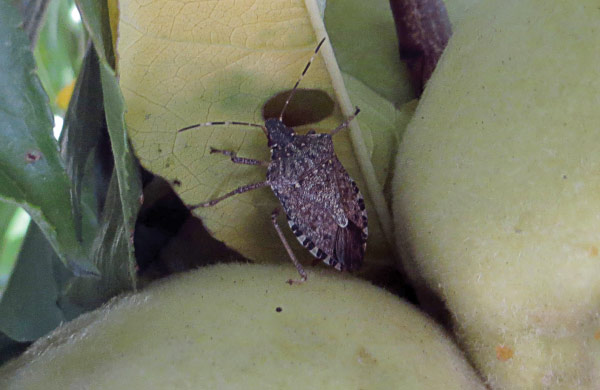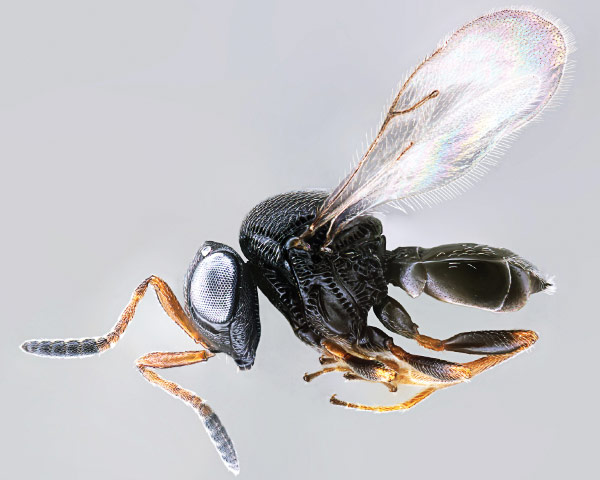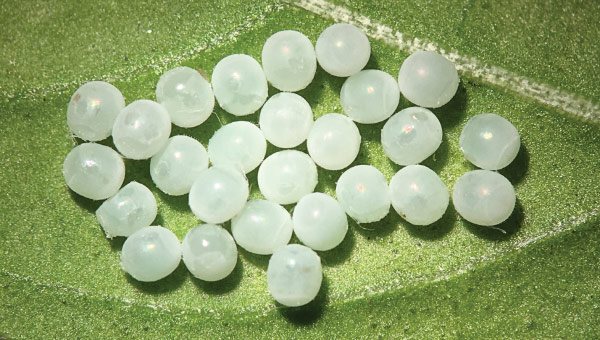Biological Control of Brown Marmorated Stink Bug
 |
|
A brown marmorated stink bug is seen hiding among peaches that have severe feeding damage. |
By Lori Spears, USU CAPS Coordinator
A version of this article first appeared in the winter 2019 issue of the Utah Pests Quarterly newsletter.
Brown marmorated stink bug (BMSB, Halyomorpha halys (Stål)) is an economically important nuisance and agricultural pest that invaded North America from eastern Asia in the late 1990s. BMSB congregates in and on buildings during the winter, and is known to attack over 170 plant species, including fruit, vegetable, and nut crops, as well as herbaceous and woody ornamentals.
A Hardy and Mobile Pest
Unfortunately, BMSB is a challenging insect to manage. Both nymphs and adults damage crops, and adults have a tough exoskeleton that is covered with a waxy, water-repellent cuticle that can help protect them from pesticide applications.
Further, adults have a strong dispersal capacity, enabling them to easily re-invade previously treated areas. Adults can theoretically fly more than 70 miles per day, although most adults fly short distances (Wiman et al. 2014; Lee and Leskey 2015). Even nymphs, which are wingless, are relatively mobile due to their strong walking capacity (Lee et al. 2014).
Problematic Reliance on Insecticides
Growers in the Mid-Atlantic region with BMSB infestations are relying on weekly, season-long applications of broad-spectrum insecticides, as integrated-management programs are still under development.
The Search for an Effective Biocontrol Agent
Broad-spectrum insecticides are costly, risk development of pest resistance, may contribute to secondary pest outbreaks, and can be harmful to beneficial insects, including biological control agents.
Natural biological control has been observed in the U.S., but not enough to manage BMSB. Generalist predators (lacewings, mantids, earwigs, lady beetles, assassin bugs, minute pirate bugs, big-eyed bugs, and spiders) feed on BMSB egg masses and nymphs (Lara et al. 2016; Morrison et al. 2016). In addition, although researchers have found at least 12 native wasp species that can parasitize egg masses of BMSB, they typically account for less than 11-percent mortality of eggs (Rice et al. 2014).
Broad-spectrum insecticides are costly, risk development of pest resistance, may contribute to secondary pest outbreaks, and can be harmful to beneficial insects.
 |
|
The samurai wasp, native to eastern Asia, is a promising biocontrol agent that has made its way to the U.S. Some states where it now occurs are releasing it. Photo by Elijah Talamas, USDA ARS. |
 |
|
BMSB eggs on a leaf. Photo by Jennifer Carr, University of Florida, Bugwood.org. |
The samurai wasp (Trissolcus japonicus) co-evolved with BMSB in eastern Asia, and there, it is highly effective, with egg parasitism rates reported to be as high as 80 percent. The wasp has been identified as the most promising agent for classical biological control of BMSB in the U.S. Starting in 2007, USDA Agricultural Research Service entomologists reared samurai wasp specimens under strict quarantine conditions with the hope of mass-releases.
Surprise Arrival of BMSB’s Natural Enemy
However, starting in 2014, adventive (wild) populations started to occur in many states, including Maryland, Virginia, Ohio, Michigan, Washington, and Oregon. It is speculated that the wasps arrived within stink bug egg masses on plant cargo shipped from Asia. Many of those wild populations became established, and because of this, some states are now able to release samurai wasps for control and research purposes, bypassing the lengthy procedures needed for introducing a new species.
Healthy BMSB eggs are barrel-shaped, one-sixteenth of an inch wide, and translucent, white, or light green in color. As eggs mature, dark triangular-shaped spots become visible. Eggs are typically laid on the underside of leaves in clusters of 20 to 30. If parasitized, however, BMSB eggs turn dark brown to black in color.
References
Lara, J., et al. 2016. Biological control program is being developed for brown marmorated stink bug. California Agriculture 70: 15–23.
Lee, D. H., A. L. Nielsen, and T. C. Leskey. 2014. Dispersal capacity and behavior of nymphal stages of Halyomorpha halys evaluated under laboratory and field conditions. Journal of Insect Behavior 27: 639–51.
Lee, D. H., and T. C. Leskey. 2015. Flight behavior of foraging and overwintering brown marmorated stink bug, Halyomorpha halys. Bulletin of Entomological Research 105: 566–573.
Morrison, W. R., C. R. Mathews, and T. C. Leskey. 2016. Frequency, efficiency, and physical characteristics of predation by generalist predators of brown marmorated stink bug eggs. Biological Control 97: 120–130.
Rice, K. B., C. J. Bergh, E. J. Bergmann, et al. 2014. Biology, ecology, and management of brown marmorated stink bug. Journal of Integrated Pest Management 5: 1–13.
Wiman, N. G., et al. 2014. Factors affecting flight capacity of brown marmorated stink bug. Journal of Pest Science 88: 37–47.
The Northeastern IPM Center promotes integrated pest management for reducing risks to human health and the environment. If republishing our news, please acknowledge the source (“From Northeast IPM Insights”) along with a link to our website.
